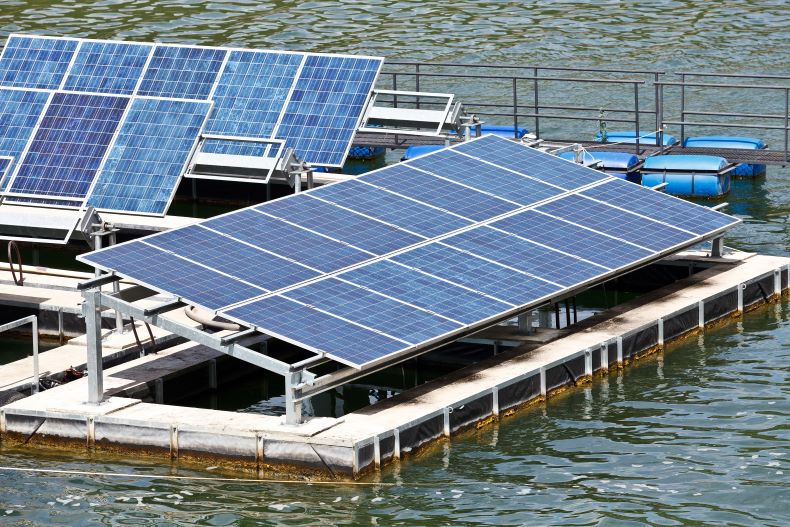Summary:
Solar energy seems to be headed to a global growth spurt, which is leading to technological advancements and new and innovative kinds of solar panel installations.
Main Article:

Solar energy appears to be heading toward a global growth spurt, due to a combination of new technology and expanding reach to consumers as it becomes more competitive with the cost of traditional energy sources.
One sign of the potential of new technology came from a Norwegian company, Ocean Sun, that announced this week that its floating solar panels—sized to fit in reservoirs for hydroelectric dams or on shallow offshore water near cities—have met Norway’s safety and environmental requirements.
Plants to make the solar panels and their carriers, called “floaters,” are also being built in China, India and Southeast Asia. According to an earlier World Bank report, the global potential for them could be as high as 400 gigawatts, or roughly the total capacity of existing photovoltaic solar panels installed on land.
“Floating solar allows for power generation to be sited much closer to areas where demand for electricity is high," the World Bank report, published in October 2018, predicted. “This makes the technology an attractive option for countries with high population density and competing uses for available land.”
It may also be attractive for Europe, especially in nations like Norway that are heavily dependent on hydroelectric dams. According to the World Bank, a solar floater would take up only 3% to 4% of the surface of an existing reservoir, but it could double the electricity generation capacity of the adjoining dam. That combination would “help utilities manage periods of low water availability” by using solar power during the day and drawing on hydropower at night.
Ocean Sun was founded three years ago with the aim of “disrupting the status quo in the solar industry.” It borrowed technology being used for offshore salmon farming to develop floating circles of polyethylene plastic membranes, 236 feet in diameter. They carry solar panels made from glass and crystalline silicon solar modules and are equipped with the junction boxes and cables necessary to connect them to power grids.
They have been tested for two years in various places in Norway, including offshore.
“The good thing about the design we have is that we are virtually sitting on the surface, so there is not much room for wind to get underneath the structure. We fit our modules onto a membrane that is in direct contact with the body of water,” explained Arnt Emil Ingulstad, the co-founder of Ocean Sun, which has sold its first unit to a buyer in Albania.
While solar floaters are slightly more expensive than arrays built on land, they are more efficient producers of electricity because their nearness to the water allows their solar panels to run cooler.
According to the World Bank, the global market for floating solar on just man-made reservoirs will be substantial. “When adding coastal waters,” the bank’s report said, “the potential becomes enormous.”
DNV GL, a global quality assurance company, awarded a “conformity statement” to Ocean Sun after verifying the safety and reliability of its floater design. It noted in an accompanying announcement that the world will need to “grow solar power by more than ten times” to close the gap between the current rate of removing carbon from electricity production and the goal of the Paris Agreement to restrict global warming by 2050.
In the U.S., a panel of researchers at Lawrence Berkeley National Laboratory reported yesterday that by the end of 2018, Americans had installed roughly 1.4 million residential rooftop solar power systems across the country.
As solar power has become cheaper and more competitive with oil- and natural gas-generated electricity, solar energy adoption has “been gradually migrating toward lower-income ranges, reflecting both a broadening and a deepening of U.S. solar markets,” the researchers noted.
Among all 2018 solar energy adopters, 27% had home values below the median price in their respective counties, and 35% had credit scores below the median range. Still, the Berkeley report said, “the overwhelming majority of systems are installed in ‘high-income states,’” led by California.
Want to go Solar? See how much you can save before the installer comes out by using the HahaSmart price checker tool and you can customize your solar-powered system with the design DIY tool.


Input your address to see if it is solar friendly and how much you can save with solar.
Great. Your address is perfect for solar. Solar incentive is still available. Select monthly utility cost and calculate the size of solar system you will need now.
| kw System size | years Payback period | Lifetime savings |
No money down, 100% finance is available.

|
|
Get the Most Advanced Solar Panel Installation Here! |
Comments